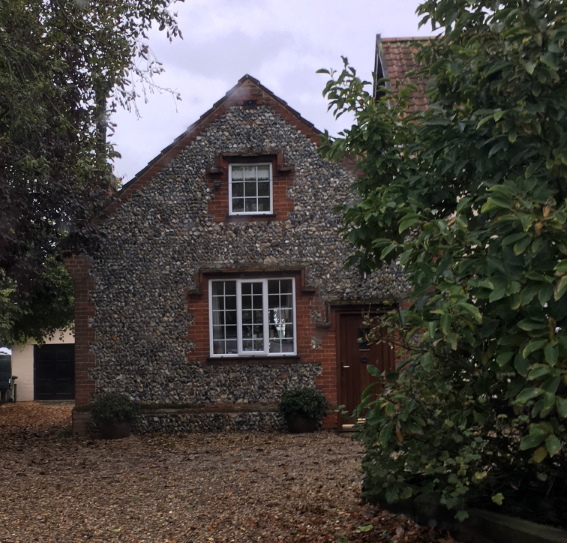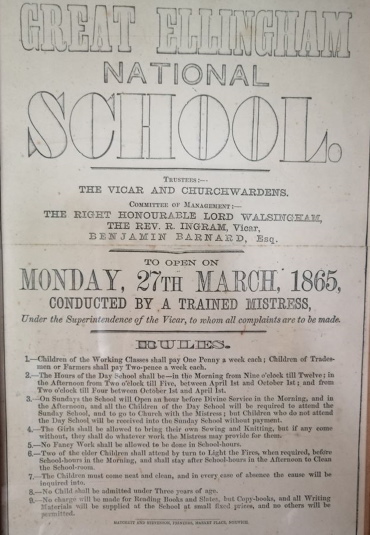
Formerly the National School built in 1865. Later used as a Reading Room and Village Hall.
During the nineteenth century, National Schools were set up by the National Society for Promoting Religious Education, for the furtherance of Christian Education and church schools. The Society was a body of the Church of England.

Poster announcing the Opening of Great Ellingham National School on 27th March, 1865. Courtesy of David Roberts
On the 27th March 1865, a National School was opened in Great Ellingham. The village already had a ‘British School’ in Long Street, which was formed in 1855.
Built at a cost of £318 for 60 children, the National School was erected along the Attleborough Road on land given by the Rt Hon Lord Walsingham. Walsingham was one of the largest landowners in Great Ellingham, and the ‘Lord of the Manor of Bury Hall’. The land was part of an arable field known as ‘Pound Close’ and was farmed by Lord Walsingham’s tenant, James Barnard who lived at Bury Hall.
According to the above Poster, the Rules of the National School were:
- Children of Working Classes shall pay One Penny a week each; Children of Tradesmen or Farmers shall pay Two-pence a week each.
- The Hours of the Day School shall be – in the Morning from Nine o’clock till Twelve; in the Afternoon from Two o’clock till Five, between April 1st and October 1st; and from Two o’clock till Four between October 1st and April 1st.
- On Sundays the School will Open an hour before Divine Service in the Morning, and in the Afternoon, and all the Children of the Day School will be required to attend the Sunday School, and to go to Church with the Mistress; but Children who do not attend the Day School will be received into the Sunday School without payment.
- The Girls shall be allowed to bring their own Sewing and Knitting, but if any come without, they shall do whatever work the Mistress may provide for them.
- No Fancy Work shall be allowed to be done in School-hours.
- Two of the elder Children shall attend by turn to Light the Fires, when required, before School-hours in the Morning, and shall stay after School-hours in the Afternoon to Clean the School-room.
- The Children must come neat and clean, and in every case of absence the cause will be inquired into.
- No Child shall be admitted under Three years of age.
- No charge will be made for Reading Books and Slates, but Copy-books, and all Writing Materials will be supplied at the School at small fixed prices, and no others will be permitted.
The Trustees confirmed that the School would be conducted by ‘a Trained Mistress’. I believe this trained mistress was Miss Ellen Richardson.
Ellen Saunders (née Richardson)
Around three and a half years after taking the position of Mistress of the National School, 23 year old Ellen Richardson married 30 year old Great Ellingham farmer, Frederick Saunders, in the Church of St James (just across the road from the National School) on October 13th, 1868.
The marriage was officiated by the Reverend Rowland Ingram, the Vicar and one of the Trustees of the National School. Perhaps a crowd of villagers, including children from the National School, congregated outside the Church to catch a glimpse of the bride and groom?
Following her marriage, Ellen Saunders continued as the Schoolmistress at the National School. The 1881 census captures 35 year old Ellen, described as a school mistress, living in Attleborough Road, Great Ellingham with her sons, William 9 and Ernest 7. The family have a visitor, 39 year old Ester (Esther) Hill. Ellen’s husband, Frederick is captured with his parents (now in their seventies) at Hill Common, Attleborough. He may, of course, only have been visiting his parents on census night.
Ten years later, the census of 1891 finds Frederick and Ellen Saunders with their sons at South Farm, Snetterton. Frederick is described as a farmer but there is no occupation given for Ellen. Accordingly it is likely that Ellen was no longer teaching at the National School.
Board Schools
Kelly’s Directory of 1896 mentions both the former British School and the former National School as being mixed ‘Board Schools’. John Field was Master of the former British School in Long Street, and ‘Miss Howlett’ at the former National School.
It was in 1896 that the new Board School was built to accommodate 200 children, including the transfer of the children from the two schools in the village. John Field became the first Schoolmaster of the new Board Schools in Hingham Road.
Today, the former National School building is part of a private house which was previously a parsonage.
Sources:
1802 Russell James Colman Plans. Great Ellingham. Catalogue Ref: C/Ca 1/84
1800 Inclosure Commissioner’s Particulars and Valuation, Great Ellingham. Norfolk Record Office. Catalogue Ref: MC2213/119
Watts. J. ‘Great Ellingham County Primary School Centenary’. (1996). Great Ellingham Primary School
http://www.victorianschool.co.uk/school%20history%20national%20schools.html accessed 14.07.2020
1881 census RG11/1974/9; RG11/1974/36
1891 census RG12/1549/125
Great Ellingham Parish Registers. Norfolk Record Office. PD/609. Also available at FamilySearch.org https://www.familysearch.org/search/image/index?owc=4J8C-CB7%3A29627201%3Fcc%3D1416598
1896 Kelly’s Directory